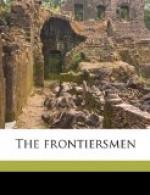57. Now from north
and south came the Wapagachik (white
comers).
58. Professing
to be friends, in big birds (ships). Who
are they?
And with this dramatic climax the ancient picture record closes.
What is known as the Modern Chronicle, a fragment, begins with the answer, “Alas! Alas! we know now who they are, these Wapinsis (East People) who came out of the sea to rob us of our lands.”
And that the modern chronicle shall be certainly correct the successor of Lekhibit (the compiler of the ancient story) is assisted by critical philologists, and Rafinesque takes issue with Holm touching a Swedish suffix in an Indian name. “Mattanikum was chief in 1645. He is called ‘Mattahorn’ by Holm, and ‘horn’ is not Lenapi!”
It is difficult to adjust one’s credulity to accept as history this singular Indian picture-record. Its authenticity is supported by the great scope of the system and the reputed subtlety and close accuracy by which abstract ideas, the origin of things, the powers of nature, the elements of religion, could be expressed and read by those conversant with the mnemonic signs,—as easily, Heckewelder says, as a piece of writing. The noted antiquary Squier, however, who in this connection has lauded Rafinesque’s industry, scientific attainments, and eager researches, states that since writing in this vein he has seen fit to read this author’s American Nations and finds it “a singular jumble of facts and fancies,” and adds that it is unfortunate that the manuscript in question should fall in this category. To praise, even with qualifications, the author without reading all his work on the subject, while certainly more amiable, is hardly more conducive to an impartial estimate than to disparage on hearsay, according to that travesty of critical judgment: “‘Que dites-vous du livre d’Hermodore?’ ’Qu’il est mauvais,’ repond Anthime ... ‘Mais l’aves-vous lu?’ ‘Non.’ dit Anthime. Quen’ajoute-t-il que Fulvie et Melanie l’ont condamne sans l’avoir lu, et qu’il est ami de Fulvie et de Melanie?”
In contrast with this method the caution and critical scrutiny with which Dr. Brinton, in his work on “The Lenape,” deliberates upon the question of the authenticity of the Walam Olum are indeed marked. He carefully examines all the details both favorable and adverse, and finally adduces the evidence of the text itself. The manuscript submitted by him to educated Indians of the Lenni Lenape is pronounced to be a genuine oral composition of a Delaware Indian in an ancient dialect, evidently dictated to one not wholly conversant with, all the terminal inflections of the words, which occasional omissions form the chief defect of the curious “Red Score.”
12. Page 324. Some authorities hold that the Talamatan (Not-of-themselves) mentioned by the Walam-Olum were the Hurons who allied themselves with the Delawares against the Tallegwi, and that Heckewelder is mistaken in stating that these confederates were the Mengwe. This story, however, follows the account of the war and the subsequent subjection of the Delawares as given by Heckewelder.




